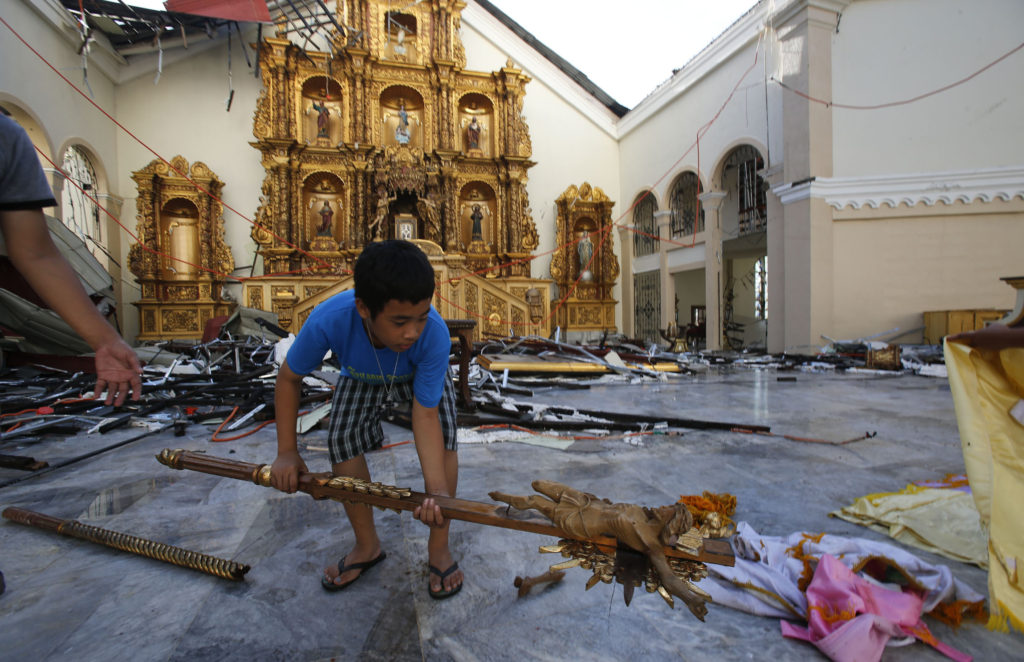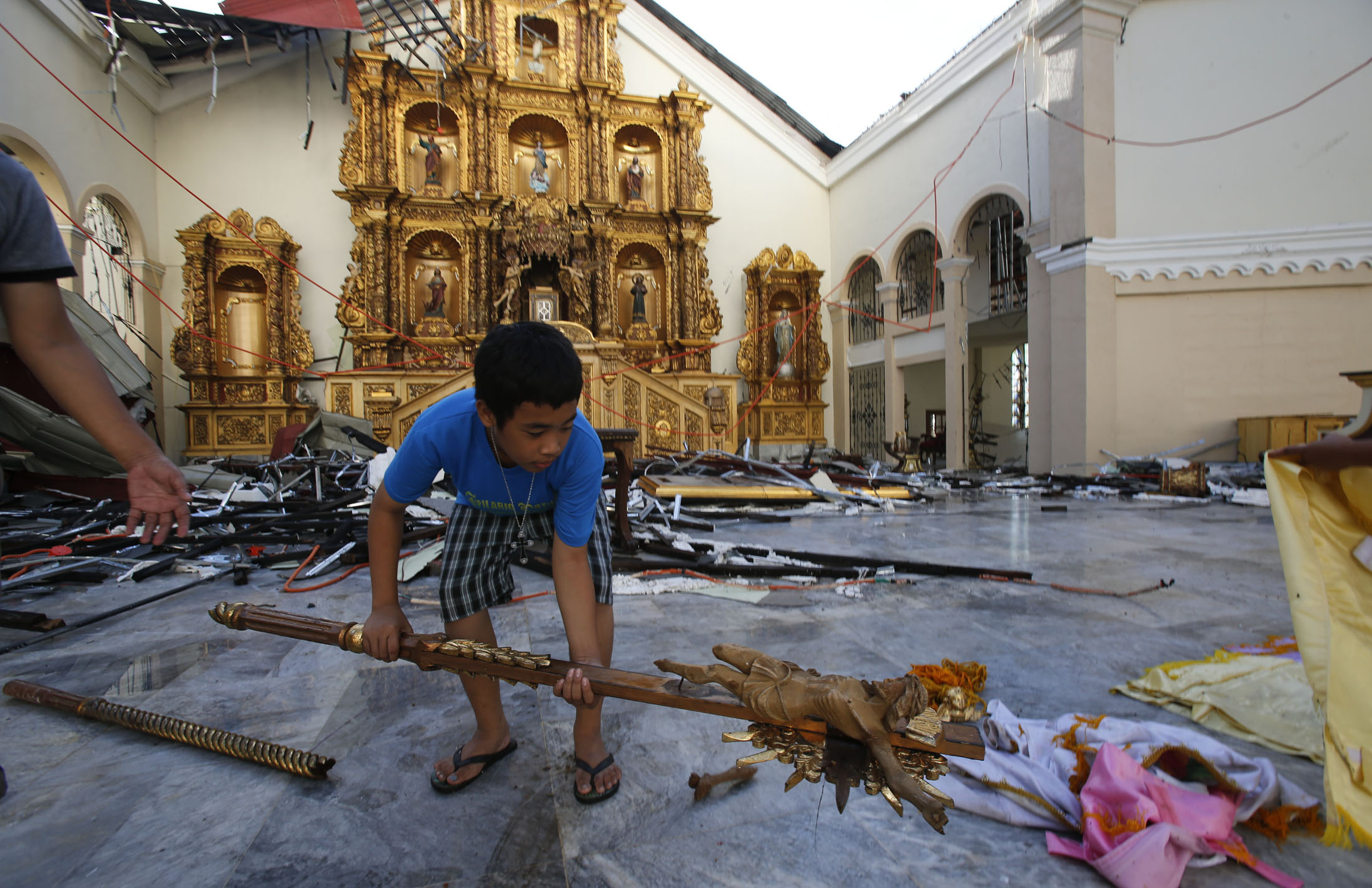
PALO, Philippines (CNS) — Since November, any time it rains the interior of the Archdiocese of Palo’s Cathedral of the Transfiguration of Our Lord gets good and wet.
Without a roof, most of the church’s interior is open to the skies.
Mass is celebrated at a portable altar set up under a tent in the one wing where the roof remains intact. Only a couple of hundred people can fit in when normally hundreds more fill the church for Sunday Masses.
Construction crews in early February were working as fast as they could to replace the roof, which was destroyed in Typhoon Haiyan. They had managed to rebuild the structure above the main altar, which still must be refurbished. Once the roof is completed, work will begin on the interior.
When the typhoon hit, the cathedral had just undergone a full renovation as part of the archdiocese’s yearlong 75th anniversary celebration. Cardinal Luis Tagle of Manila joined Palo Archbishop John Du to close the celebration Nov. 28 with Mass. A downpour occurred during the liturgy, bringing tears to many worshippers huddled under umbrellas and a tarp strung from wall to wall.
The cathedral is one of dozens of churches, missions and chapels in nine dioceses and archdioceses seriously damaged or destroyed by the typhoon when it slammed the Visayas region of the central Philippines with 195-mile-an-hour winds and an unprecedented storm surge Nov. 8.
At historic Santo Nino Church in Tacloban, Mass is celebrated, rain or shine. A 15-minute rainstorm as Mass began one afternoon in early February sent worshippers searching for pews free from dripping water and left large puddles of water throughout the church.
During the height of Haiyan, many residents took refuge in local churches and chapels that served as evacuation centers, even though the buildings sustained heavy damage.
Seventy chapels and churches in the Palo Archdiocese were destroyed by the typhoon, Father Oscar Florencio, rector of archdiocese’s St. John the Evangelist School of Theology, told a delegation of church leaders from around the world during a Feb. 5 meeting at the badly damaged Palo cathedral offices.
Church buildings in the Borongan Diocese in Eastern Samar province also sustained serious damage. Churches in seven other dioceses sustained some type of damage, the Catholic Bishops’ Conference of the Philippines reported.
Father Florencio and other priests urged officials from Catholic Relief Services, the U.S. Conference of Catholic Bishops, Caritas Australia, Trocaire, the Irish Catholic aid agency, and CAFOD, the relief and development agency of the Catholic bishops of England and Wales, to expand their typhoon response to include church reconstruction.
“We are appealing to you for the rebuilding because it is difficult for the archdiocese,” Father Florencio said.
Other priests said they were using tarps distributed by Catholic aid agencies to protect church interiors.
Father Florencio also asked for support for St. John the Evangelist and neighboring Sacred Heart Seminary. About 200 students are enrolled in the two schools, including 41 men studying for the priesthood.
In response, Archbishop Joseph E. Kurtz of Louisville, Ky., USCCB president, assured the priests that the U.S. church would work with the Philippine church on reconstruction, but he said any support would have to be coordinated through the Philippine bishops’ conference.
He explained that relief agencies’ priority in an emergency is to assist people in need of food, shelter and water, sanitation and hygiene services.
“It’s not (Catholic Relief Services’) purpose to do the church rebuilding,” Archbishop Kurtz told the priests.
Through early February, the USCCB had raised about $9 million for Philippines typhoon relief from parishes. About two-thirds of the funds were designated by donors for humanitarian aid, while the remaining amount could be used for other purposes, Archbishop Kurtz said.
Meanwhile, Joe Curry, country representative in the Philippines for CRS, said the agency had raised about $48 million for humanitarian assistance.
Archbishop Philip Wilson of Adelaide, Australia, chairman of Caritas Australia’s national council, echoed his American colleagues, explaining that his agency prioritizes emergency needs.
“We’re very clear about the response that Caritas Australia can make in the situation,” he said. “Caritas does not provide funds for church (rebuilding) purposes. Our job is to provide relief really for the ones who experienced the terrible fury of the typhoon. However, we’re very sensitive to the fact that you have other needs.”
The archbishop suggested that the president of the Philippines bishops’ conference work with the Australian bishops’ conference to secure reconstruction funds.
“I assure you we would be very happy to do what we can,” he said.
In a meeting with Cardinal Tagle in Manila Feb. 3, Archbishop Kurtz pointed to a program to rebuild churches, schools and convents in Haiti and said it could serve as a model for rebuilding church facilities in the Philippines. Under the Partnership for Church Reconstruction in Haiti, or PROCHE, established after the 2010 earthquake, the USCCB works with the French and Haitian bishops’ conferences and Adveniat, the German bishops’ agency for solidarity in Latin America, to prioritize projects in the earthquake zone.
PROCHE has allocated about $17 million for church building projects. About $16 million remains to be allocated.
— Dennis Sadowski, Catholic News Service.






